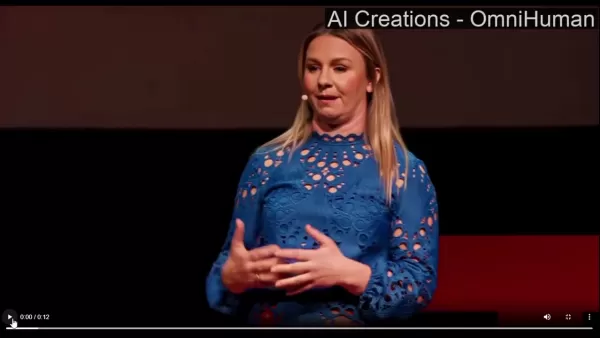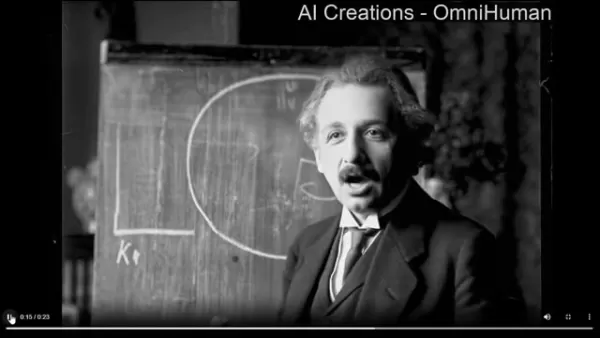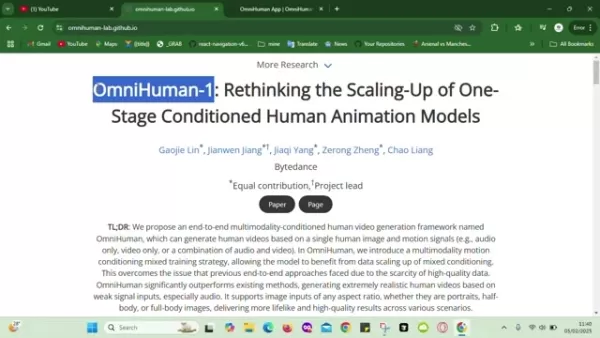OmniHuman-1: Revolutionizing AI Deepfake Video Creation
In the ever-changing world of artificial intelligence, a revolutionary tool has emerged that's set to transform how we create videos. OmniHuman-1, developed by ByteDance, the powerhouse behind TikTok, is an advanced AI-driven deepfake video tool that's redefining what's possible with single-stage conditioned human animation models. This cutting-edge technology is making it easier than ever to generate realistic human videos, and this blog delves into the remarkable features of OmniHuman-1 and its potential to shape the future of AI video creation.
Key Points
- OmniHuman-1 is an AI deepfake video tool crafted by ByteDance.
- It's exceptional at creating realistic human videos using just a single image and motion signals.
- The tool accepts a variety of input types, including audio, video, and images.
- OmniHuman-1 employs a multimodal motion conditioning mixed training strategy for improved data scaling.
- It surpasses existing techniques, offering more lifelike and superior quality outputs across different scenarios.
- The technology is versatile, capable of producing cartoons and other artificial objects as well.
Understanding OmniHuman-1
What is OmniHuman-1?
OmniHuman-1 is an end-to-end multimodal-conditioned human video generation framework developed by ByteDance. It's designed to create human videos from a single image and motion signals, such as audio and video. The unique aspect of OmniHuman-1 is its multimodal motion conditioning mixed training strategy, which enables the scaling of mixed conditioning data in ways that were previously unattainable. This approach significantly outstrips existing methods, allowing for the creation of remarkably realistic videos from minimal cues, including audio. The tool also accommodates images of various aspect ratios, whether portraits, half-body, or full-body shots, resulting in lifelike videos across diverse settings. In essence, OmniHuman-1 is pushing the boundaries of scaling up one-stage conditioned human animation models.
is an end-to-end multimodal-conditioned human video generation framework developed by ByteDance. It's designed to create human videos from a single image and motion signals, such as audio and video. The unique aspect of OmniHuman-1 is its multimodal motion conditioning mixed training strategy, which enables the scaling of mixed conditioning data in ways that were previously unattainable. This approach significantly outstrips existing methods, allowing for the creation of remarkably realistic videos from minimal cues, including audio. The tool also accommodates images of various aspect ratios, whether portraits, half-body, or full-body shots, resulting in lifelike videos across diverse settings. In essence, OmniHuman-1 is pushing the boundaries of scaling up one-stage conditioned human animation models.
Coming from ByteDance, the creators of TikTok, OmniHuman-1 has the backing of a major player in the tech world, which is likely to drive its adoption even further. As AI tools continue to evolve, we're inching closer to achieving Artificial General Intelligence (AGI). OmniHuman-1 is a significant step forward, making it increasingly challenging to distinguish between real humans and deepfake videos.
The Technology Behind OmniHuman-1
The development of OmniHuman-1 was conducted in three crucial stages, enabling training across a variety of conditions and resulting in videos that support diverse visual and audio styles. The remarkable thing about OmniHuman-1 is that it only needs a single image and audio to produce results. It can generate realistic human videos at any aspect ratio and body proportion, whether it's a portrait, half-body, or full-body shot, with realism achieved through detailed aspects like motion, lighting, and texture.
was conducted in three crucial stages, enabling training across a variety of conditions and resulting in videos that support diverse visual and audio styles. The remarkable thing about OmniHuman-1 is that it only needs a single image and audio to produce results. It can generate realistic human videos at any aspect ratio and body proportion, whether it's a portrait, half-body, or full-body shot, with realism achieved through detailed aspects like motion, lighting, and texture.
OmniHuman-1 is versatile, supporting various music styles and accommodating multiple body poses and singing forms. It can handle high-pitched songs and display different motion styles for various types of music. For the best video quality, it's advisable to use the highest possible reference image.
OmniHuman-1 Creators and AI's Future
The team behind OmniHuman-1 includes Gaojie Lin, Jianwen Jiang, Jiaqi Yang, Zerong Zheng, and Chao Liang, all of whom are part of ByteDance. By early 2025, distinguishing between real humans and deepfakes in videos was becoming nearly impossible. OmniHuman-1 is pushing the envelope of deepfake AI technologies, and as our understanding of AI deepens and more AGI solutions emerge, these technologies will continue to evolve. With tools like OmniHuman-1, content creators can now generate and automate videos in ways that were once unimaginable.
The Future of AI Video Generation
Looking Ahead
The advent of OmniHuman-1 heralds a new era in AI video generation, characterized by unparalleled realism and accessibility. As AI technology progresses, we can anticipate the emergence of even more advanced tools that will further blur the lines between real and synthetic content.
 This evolution will undoubtedly impact various industries, from entertainment and education to marketing and communications. To ensure the responsible development and deployment of AI video technology, it's essential to create a collaborative ecosystem that includes researchers, policymakers, and industry stakeholders.
This evolution will undoubtedly impact various industries, from entertainment and education to marketing and communications. To ensure the responsible development and deployment of AI video technology, it's essential to create a collaborative ecosystem that includes researchers, policymakers, and industry stakeholders.
By embracing innovation while maintaining ethical standards, we can harness the full potential of AI to create meaningful and transformative video experiences for everyone.
OmniHuman-1 Pricing
Future Costs of OmniHuman-1
As of now, there's no pricing structure available for OmniHuman-1. However, as more AI video tools develop, costs are likely to decrease over time. If deepfake technology continues to advance, it could revolutionize workplaces by enabling the virtualization of people. Pricing for such AI tools might be based on usage time or could follow a subscription model, similar to other AI products. Currently, there's no information on when OmniHuman-1 might become available to the public.
OmniHuman-1: Pros and Cons
Pros
- Realistic Human Video Generation: OmniHuman-1 produces incredibly lifelike human videos.
- Multimodal Conditioning: It supports a wide range of input modalities for greater control.
- Improved Data Scaling: Utilizes a multimodal motion conditioning mixed training strategy for better data scaling.
- Enhanced Efficiency: Streamlines video production, saving time and resources.
- Expanded Creative Possibilities: Allows for the creation of unique and engaging content.
Cons
- Ethical Concerns: Raises issues related to misinformation and misuse.
- Potential for Deception: Deepfake videos can manipulate public opinion and spread false information.
- Lack of Transparency: The origin and authenticity of AI-generated videos can be hard to verify.
- Regulation Challenges: The rapid advancement of deepfake technology complicates regulatory frameworks.
- Technical Expertise: Requires a certain level of technical knowledge to operate and customize.
OmniHuman-1's Top AI Features
Best Features of OmniHuman-1
AI is advancing at an incredible pace, and OmniHuman-1 boasts several standout features. Here are some of the top AI features it offers:
- Single-image human video generation

- Multimodal conditionings for audio, video, and images
- Realistic AI video with all body proportions
- Comprehensive visual and audio styles
- Generates multiple body poses with accurate motions
OmniHuman-1's ability to produce high-quality deepfake videos sets it apart in the market.
OmniHuman-1 Use Cases
How to Apply OmniHuman-1
Although OmniHuman-1 isn't publicly available yet, we can still imagine its potential applications. Here are some possibilities:
- Automated Content Creation: Generate high-quality video content without extensive filming or animation.
- Virtual Assistants: Create realistic virtual assistants or presenters for online platforms.
- Personalized Learning: Develop custom educational videos tailored to individual student needs.
- Entertainment: Produce deepfake videos for movies, TV shows, and online content.
- Accessibility: Enable video creation for those lacking resources or skills for traditional methods.
Frequently Asked Questions About OmniHuman-1
What is the primary function of OmniHuman-1?
OmniHuman-1 is designed to generate realistic human videos using a single human image and motion signals. It supports end-to-end multimodal-conditioned human video generation, offering unprecedented control and realism in AI-driven video creation.
Who developed OmniHuman-1?
OmniHuman-1 was developed by ByteDance, the parent company of TikTok. ByteDance's AI research group created this deepfake AI video tool.
What input modalities does OmniHuman-1 support?
The tool can generate extremely realistic human videos based on weak signal inputs, particularly audio. It supports image inputs of any aspect ratio, delivering more lifelike and high-quality results across various scenarios.
What's unique about OmniHuman-1’s training strategy?
OmniHuman-1 employs a multimodal motion conditioning mixed training strategy that allows for data scaling of mixed conditioning, overcoming the limitations faced by previous end-to-end approaches due to the scarcity of high-quality data.
Is OmniHuman-1 publicly available?
As of early 2025, OmniHuman-1 is not yet publicly available. However, given ByteDance's focus on AI and video creation, it's possible that OmniHuman-1 will become available in the future.
Related Questions
How can AI deepfake technology improve content creation?
AI deepfake technologies like OmniHuman-1 offer numerous benefits to content creators. They enable the creation of high-quality video content with minimal resources, allowing for rapid prototyping and iteration. These tools also make video creation more accessible to those without extensive technical skills or equipment. AI deepfake technologies can generate localized content, create personalized viewer experiences, and enhance existing videos with realistic animations and effects. The use of AI leads to greater efficiency, creativity, and cost-effectiveness in video production, resulting in richer and more engaging content for audiences. In the near future, distinguishing between real and fake content will become increasingly challenging, which is great for creators seeking automation but problematic for verifying sources.
What are the ethical considerations surrounding deepfake technology?
Despite the potential benefits, deepfake technology also raises several ethical concerns. The ability to create realistic yet fabricated videos poses risks related to misinformation, defamation, and privacy violations. Deepfakes can be used to spread false narratives, damage reputations, and manipulate public opinion. The proliferation of deepfake technology necessitates the development of robust detection methods and regulations to mitigate potential misuse. It's crucial for developers and users of AI deepfake tools to adhere to ethical guidelines and prioritize transparency and accountability. Educating the public about the capabilities and limitations of deepfake technology is also essential for promoting critical thinking and media literacy. Only with careful management can the benefits of deepfake technology be realized while minimizing its downsides.
Related article
 Topaz DeNoise AI: Best Noise Reduction Tool in 2025 – Full Guide
In the competitive world of digital photography, image clarity remains paramount. Photographers at all skill levels contend with digital noise that compromises otherwise excellent shots. Topaz DeNoise AI emerges as a cutting-edge solution, harnessing
Topaz DeNoise AI: Best Noise Reduction Tool in 2025 – Full Guide
In the competitive world of digital photography, image clarity remains paramount. Photographers at all skill levels contend with digital noise that compromises otherwise excellent shots. Topaz DeNoise AI emerges as a cutting-edge solution, harnessing
 Master Emerald Kaizo Nuzlocke: Ultimate Survival & Strategy Guide
Emerald Kaizo stands as one of the most formidable Pokémon ROM hacks ever conceived. While attempting a Nuzlocke run exponentially increases the challenge, victory remains achievable through meticulous planning and strategic execution. This definitiv
Master Emerald Kaizo Nuzlocke: Ultimate Survival & Strategy Guide
Emerald Kaizo stands as one of the most formidable Pokémon ROM hacks ever conceived. While attempting a Nuzlocke run exponentially increases the challenge, victory remains achievable through meticulous planning and strategic execution. This definitiv
 AI-Powered Cover Letters: Expert Guide for Journal Submissions
In today's competitive academic publishing environment, crafting an effective cover letter can make the crucial difference in your manuscript's acceptance. Discover how AI-powered tools like ChatGPT can streamline this essential task, helping you cre
Comments (2)
0/200
AI-Powered Cover Letters: Expert Guide for Journal Submissions
In today's competitive academic publishing environment, crafting an effective cover letter can make the crucial difference in your manuscript's acceptance. Discover how AI-powered tools like ChatGPT can streamline this essential task, helping you cre
Comments (2)
0/200
![RichardAdams]() RichardAdams
RichardAdams
 July 28, 2025 at 4:23:07 AM EDT
July 28, 2025 at 4:23:07 AM EDT
This AI deepfake tool sounds wild! Imagine creating hyper-realistic videos with just a few clicks. Excited to see how creators use it, but a bit worried about misuse too. 😅


 0
0
![KennethJones]() KennethJones
KennethJones
 July 22, 2025 at 3:35:51 AM EDT
July 22, 2025 at 3:35:51 AM EDT
This OmniHuman-1 sounds like a game-changer for video creation! 😮 I'm curious how it stacks up against other deepfake tools in terms of ease and quality. Anyone tried it yet?


 0
0
In the ever-changing world of artificial intelligence, a revolutionary tool has emerged that's set to transform how we create videos. OmniHuman-1, developed by ByteDance, the powerhouse behind TikTok, is an advanced AI-driven deepfake video tool that's redefining what's possible with single-stage conditioned human animation models. This cutting-edge technology is making it easier than ever to generate realistic human videos, and this blog delves into the remarkable features of OmniHuman-1 and its potential to shape the future of AI video creation.
Key Points
- OmniHuman-1 is an AI deepfake video tool crafted by ByteDance.
- It's exceptional at creating realistic human videos using just a single image and motion signals.
- The tool accepts a variety of input types, including audio, video, and images.
- OmniHuman-1 employs a multimodal motion conditioning mixed training strategy for improved data scaling.
- It surpasses existing techniques, offering more lifelike and superior quality outputs across different scenarios.
- The technology is versatile, capable of producing cartoons and other artificial objects as well.
Understanding OmniHuman-1
What is OmniHuman-1?
OmniHuman-1 is an end-to-end multimodal-conditioned human video generation framework developed by ByteDance. It's designed to create human videos from a single image and motion signals, such as audio and video. The unique aspect of OmniHuman-1 is its multimodal motion conditioning mixed training strategy, which enables the scaling of mixed conditioning data in ways that were previously unattainable. This approach significantly outstrips existing methods, allowing for the creation of remarkably realistic videos from minimal cues, including audio. The tool also accommodates images of various aspect ratios, whether portraits, half-body, or full-body shots, resulting in lifelike videos across diverse settings. In essence, OmniHuman-1 is pushing the boundaries of scaling up one-stage conditioned human animation models.
is an end-to-end multimodal-conditioned human video generation framework developed by ByteDance. It's designed to create human videos from a single image and motion signals, such as audio and video. The unique aspect of OmniHuman-1 is its multimodal motion conditioning mixed training strategy, which enables the scaling of mixed conditioning data in ways that were previously unattainable. This approach significantly outstrips existing methods, allowing for the creation of remarkably realistic videos from minimal cues, including audio. The tool also accommodates images of various aspect ratios, whether portraits, half-body, or full-body shots, resulting in lifelike videos across diverse settings. In essence, OmniHuman-1 is pushing the boundaries of scaling up one-stage conditioned human animation models.
Coming from ByteDance, the creators of TikTok, OmniHuman-1 has the backing of a major player in the tech world, which is likely to drive its adoption even further. As AI tools continue to evolve, we're inching closer to achieving Artificial General Intelligence (AGI). OmniHuman-1 is a significant step forward, making it increasingly challenging to distinguish between real humans and deepfake videos.
The Technology Behind OmniHuman-1
The development of OmniHuman-1 was conducted in three crucial stages, enabling training across a variety of conditions and resulting in videos that support diverse visual and audio styles. The remarkable thing about OmniHuman-1 is that it only needs a single image and audio to produce results. It can generate realistic human videos at any aspect ratio and body proportion, whether it's a portrait, half-body, or full-body shot, with realism achieved through detailed aspects like motion, lighting, and texture.
was conducted in three crucial stages, enabling training across a variety of conditions and resulting in videos that support diverse visual and audio styles. The remarkable thing about OmniHuman-1 is that it only needs a single image and audio to produce results. It can generate realistic human videos at any aspect ratio and body proportion, whether it's a portrait, half-body, or full-body shot, with realism achieved through detailed aspects like motion, lighting, and texture.
OmniHuman-1 is versatile, supporting various music styles and accommodating multiple body poses and singing forms. It can handle high-pitched songs and display different motion styles for various types of music. For the best video quality, it's advisable to use the highest possible reference image.
OmniHuman-1 Creators and AI's Future
The team behind OmniHuman-1 includes Gaojie Lin, Jianwen Jiang, Jiaqi Yang, Zerong Zheng, and Chao Liang, all of whom are part of ByteDance. By early 2025, distinguishing between real humans and deepfakes in videos was becoming nearly impossible. OmniHuman-1 is pushing the envelope of deepfake AI technologies, and as our understanding of AI deepens and more AGI solutions emerge, these technologies will continue to evolve. With tools like OmniHuman-1, content creators can now generate and automate videos in ways that were once unimaginable.
The Future of AI Video Generation
Looking Ahead
The advent of OmniHuman-1 heralds a new era in AI video generation, characterized by unparalleled realism and accessibility. As AI technology progresses, we can anticipate the emergence of even more advanced tools that will further blur the lines between real and synthetic content.
 This evolution will undoubtedly impact various industries, from entertainment and education to marketing and communications. To ensure the responsible development and deployment of AI video technology, it's essential to create a collaborative ecosystem that includes researchers, policymakers, and industry stakeholders.
This evolution will undoubtedly impact various industries, from entertainment and education to marketing and communications. To ensure the responsible development and deployment of AI video technology, it's essential to create a collaborative ecosystem that includes researchers, policymakers, and industry stakeholders.
By embracing innovation while maintaining ethical standards, we can harness the full potential of AI to create meaningful and transformative video experiences for everyone.
OmniHuman-1 Pricing
Future Costs of OmniHuman-1
As of now, there's no pricing structure available for OmniHuman-1. However, as more AI video tools develop, costs are likely to decrease over time. If deepfake technology continues to advance, it could revolutionize workplaces by enabling the virtualization of people. Pricing for such AI tools might be based on usage time or could follow a subscription model, similar to other AI products. Currently, there's no information on when OmniHuman-1 might become available to the public.
OmniHuman-1: Pros and Cons
Pros
- Realistic Human Video Generation: OmniHuman-1 produces incredibly lifelike human videos.
- Multimodal Conditioning: It supports a wide range of input modalities for greater control.
- Improved Data Scaling: Utilizes a multimodal motion conditioning mixed training strategy for better data scaling.
- Enhanced Efficiency: Streamlines video production, saving time and resources.
- Expanded Creative Possibilities: Allows for the creation of unique and engaging content.
Cons
- Ethical Concerns: Raises issues related to misinformation and misuse.
- Potential for Deception: Deepfake videos can manipulate public opinion and spread false information.
- Lack of Transparency: The origin and authenticity of AI-generated videos can be hard to verify.
- Regulation Challenges: The rapid advancement of deepfake technology complicates regulatory frameworks.
- Technical Expertise: Requires a certain level of technical knowledge to operate and customize.
OmniHuman-1's Top AI Features
Best Features of OmniHuman-1
AI is advancing at an incredible pace, and OmniHuman-1 boasts several standout features. Here are some of the top AI features it offers:
- Single-image human video generation

- Multimodal conditionings for audio, video, and images
- Realistic AI video with all body proportions
- Comprehensive visual and audio styles
- Generates multiple body poses with accurate motions
OmniHuman-1's ability to produce high-quality deepfake videos sets it apart in the market.
OmniHuman-1 Use Cases
How to Apply OmniHuman-1
Although OmniHuman-1 isn't publicly available yet, we can still imagine its potential applications. Here are some possibilities:
- Automated Content Creation: Generate high-quality video content without extensive filming or animation.
- Virtual Assistants: Create realistic virtual assistants or presenters for online platforms.
- Personalized Learning: Develop custom educational videos tailored to individual student needs.
- Entertainment: Produce deepfake videos for movies, TV shows, and online content.
- Accessibility: Enable video creation for those lacking resources or skills for traditional methods.
Frequently Asked Questions About OmniHuman-1
What is the primary function of OmniHuman-1?
OmniHuman-1 is designed to generate realistic human videos using a single human image and motion signals. It supports end-to-end multimodal-conditioned human video generation, offering unprecedented control and realism in AI-driven video creation.
Who developed OmniHuman-1?
OmniHuman-1 was developed by ByteDance, the parent company of TikTok. ByteDance's AI research group created this deepfake AI video tool.
What input modalities does OmniHuman-1 support?
The tool can generate extremely realistic human videos based on weak signal inputs, particularly audio. It supports image inputs of any aspect ratio, delivering more lifelike and high-quality results across various scenarios.
What's unique about OmniHuman-1’s training strategy?
OmniHuman-1 employs a multimodal motion conditioning mixed training strategy that allows for data scaling of mixed conditioning, overcoming the limitations faced by previous end-to-end approaches due to the scarcity of high-quality data.
Is OmniHuman-1 publicly available?
As of early 2025, OmniHuman-1 is not yet publicly available. However, given ByteDance's focus on AI and video creation, it's possible that OmniHuman-1 will become available in the future.
Related Questions
How can AI deepfake technology improve content creation?
AI deepfake technologies like OmniHuman-1 offer numerous benefits to content creators. They enable the creation of high-quality video content with minimal resources, allowing for rapid prototyping and iteration. These tools also make video creation more accessible to those without extensive technical skills or equipment. AI deepfake technologies can generate localized content, create personalized viewer experiences, and enhance existing videos with realistic animations and effects. The use of AI leads to greater efficiency, creativity, and cost-effectiveness in video production, resulting in richer and more engaging content for audiences. In the near future, distinguishing between real and fake content will become increasingly challenging, which is great for creators seeking automation but problematic for verifying sources.
What are the ethical considerations surrounding deepfake technology?
Despite the potential benefits, deepfake technology also raises several ethical concerns. The ability to create realistic yet fabricated videos poses risks related to misinformation, defamation, and privacy violations. Deepfakes can be used to spread false narratives, damage reputations, and manipulate public opinion. The proliferation of deepfake technology necessitates the development of robust detection methods and regulations to mitigate potential misuse. It's crucial for developers and users of AI deepfake tools to adhere to ethical guidelines and prioritize transparency and accountability. Educating the public about the capabilities and limitations of deepfake technology is also essential for promoting critical thinking and media literacy. Only with careful management can the benefits of deepfake technology be realized while minimizing its downsides.
 Topaz DeNoise AI: Best Noise Reduction Tool in 2025 – Full Guide
In the competitive world of digital photography, image clarity remains paramount. Photographers at all skill levels contend with digital noise that compromises otherwise excellent shots. Topaz DeNoise AI emerges as a cutting-edge solution, harnessing
Topaz DeNoise AI: Best Noise Reduction Tool in 2025 – Full Guide
In the competitive world of digital photography, image clarity remains paramount. Photographers at all skill levels contend with digital noise that compromises otherwise excellent shots. Topaz DeNoise AI emerges as a cutting-edge solution, harnessing
 Master Emerald Kaizo Nuzlocke: Ultimate Survival & Strategy Guide
Emerald Kaizo stands as one of the most formidable Pokémon ROM hacks ever conceived. While attempting a Nuzlocke run exponentially increases the challenge, victory remains achievable through meticulous planning and strategic execution. This definitiv
Master Emerald Kaizo Nuzlocke: Ultimate Survival & Strategy Guide
Emerald Kaizo stands as one of the most formidable Pokémon ROM hacks ever conceived. While attempting a Nuzlocke run exponentially increases the challenge, victory remains achievable through meticulous planning and strategic execution. This definitiv
 AI-Powered Cover Letters: Expert Guide for Journal Submissions
In today's competitive academic publishing environment, crafting an effective cover letter can make the crucial difference in your manuscript's acceptance. Discover how AI-powered tools like ChatGPT can streamline this essential task, helping you cre
AI-Powered Cover Letters: Expert Guide for Journal Submissions
In today's competitive academic publishing environment, crafting an effective cover letter can make the crucial difference in your manuscript's acceptance. Discover how AI-powered tools like ChatGPT can streamline this essential task, helping you cre
 July 28, 2025 at 4:23:07 AM EDT
July 28, 2025 at 4:23:07 AM EDT
This AI deepfake tool sounds wild! Imagine creating hyper-realistic videos with just a few clicks. Excited to see how creators use it, but a bit worried about misuse too. 😅


 0
0
 July 22, 2025 at 3:35:51 AM EDT
July 22, 2025 at 3:35:51 AM EDT
This OmniHuman-1 sounds like a game-changer for video creation! 😮 I'm curious how it stacks up against other deepfake tools in terms of ease and quality. Anyone tried it yet?


 0
0





























